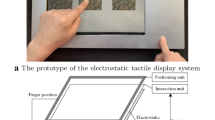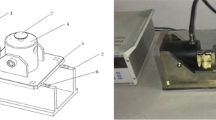Abstract
Image-textures contain most surface features of real objects that are largely missing from virtual tactile interactions. This paper presents a tactile model for rendering image-textures based on electrovibration, which is achieved by varying stimuli signals to modulate friction between the finger and the touchscreen. We do research on the relationships between human tactile sensation and stimuli signals through experiments. According to the relationships, we establish a mapping model based on gradients of image-textures which are gained by the Roberts filter. We use the mapping model to synthetize the frequency and amplitude of stimuli signals for rendering image-textures as a user interacts with our tactile prototype. Specifically, stimuli frequency mainly reflects hardness and granularity of image-textures, stimuli amplitude mainly reflects heights of image-textures. We compare the proposed model with the model based on stimuli amplitude through experiments on the prototype. Results show that the proposed model can effectively enhance tactile reality of image-textures.















Similar content being viewed by others
References
Xia, P., Lopes, A.M., Restivo, M.T.: Virtual reality and haptics for dental surgery: a personal review. Vis. Comput. 29(5), 433–447 (2013)
Kaczmarek, K.A., Nammi, K., Agarwal, A.K., et al.: Polarity effect in electrovibration for tactile display. Biomed. Eng. IEEE Trans. 53(10), 2047–2054 (2006)
Kim, S. C., Israr, A., Poupyrev, I.: Tactile rendering of 3D features on touch surfaces. In: Proceedings of the 26th annual ACM symposium on User interface software and technology, pp. 531–538 (2013)
Xu, C., Israr, A., Poupyrev, I., Bau, O.,Harrison, C.: Tactile display for the visually impaired using TeslaTouch. In: CHI’11 extended abstracts on human factors in computing systems, pp. 317-322 (2011)
Israr, A., Bau, O., Kim, S. C., Poupyrev, I.: Tactile feedback on flat surfaces for the visually impaired. In CHI’12 extended abstracts on human factors in computing systems pp.1571–1576 (2012)
Yu, G., Wang, D., Zhang, Y., Xiao, J.: Simulating sharp geometric features in six degrees-of-freedom haptic rendering. Haptics, IEEE Trans. 8(1), 67–78 (2015)
Culbertson, H., Unwin, J., Kuchenbecker, K.J.: Modeling and rendering realistic textures from unconstrained tool-surface interactions. Haptics, IEEE Trans. 7(3), 381–393 (2014)
Bau, O., Poupyrev, I., Israr, A., Harrison, C. TeslaTouch: electrovibration for touch surfaces. In: Proceedings of the 23nd annual ACM symposium on User interface software and technology. pp. 283–292 (2010)
Wijekoon, D., Cecchinato, M.E., Hoggan, E., Linjama, J.: Electrostatic modulated friction as tactile feedback: intensity perception. Haptics: Perception. Devices, Mobility, and Communication, pp. 613–624. Springer, Berlin (2012)
Minsky, M., Ming, O.Y., Steele, O., Brooks Jr., F.P., Behensky, M.: Feeling and seeing: issues in force display. ACM SIGGRAPH Comput. Graph. 24(2), 235–241 (1990)
Vasudevan, H., Manivannan, M.: Tangible images: runtime generation of haptic textures from images. In: Haptic interfaces for virtual environment and teleoperator systems, 2008. haptics 2008. symposium on. pp. 357–360 (2008)
Saga, S., Deguchi, K.: Lateral-force-based 2.5-dimensional tactile display for touch screen. In: Haptics Symposium (HAPTICS), 2012 IEEE. pp. 15–22 (2012)
Massie, T.H., Salisbury, J.K.: The phantom haptic interface: a device for probing virtual objects. In: Proceedings of the ASME winter annual meeting, symposium on haptic interfaces for virtual environment and teleoperator systems (1994)
Sang-Ho, K., Sekiyama, K., Fukuda, T., Tanaka, K., Itoigawa, K.: Development of dynamically re-formable input device in tactile and visual interaction. Proc. Int. Sympos. Micro-NanoMechatron. Human Sci. 2007, 544–549 (2007)
Wu, J., Song, A., Zou, C.: A novel haptic texture display based on image processing. In: IEEE International Conference on Robotics and Biomimetics, 2007, ROBIO 2007, pp. 1315–1320 (2007)
Martínez, J., García, A.S., Molina, J.P., Martínez, D., González, P.: An empirical evaluation of different haptic feedback for shape and texture recognition. Vis. Comput. Int. J. Comput. Graph. 29(2), 111–121 (2013)
Chouvardas, V.G., Miliou, A.N., Hatalis, M.K.: Tactile displays: overview and recent advances. Displays 29(3), 185–194 (2008)
Ikei, Y., Wakamatsu, K., Fukuda, S.: Texture presentation by vibratory tactile display-image based presentation of a tactile texture. In: Virtual Reality Annual International Symposium, 1997, IEEE 1997, p. 199 (1997)
Grimnes, S.: Electrovibration, cutaneous sensation of microampere current. Acta Physiol. Scand. 118(1), 19–25 (1983)
Strong, R.M.: An explorable electrotactile display .Doctoral dissertation, Massachusetts Institute of Technology (1970)
Nixon, M.: Feature extraction\(\backslash \)and image processing. Academic Press (2008)
Brodatz texture library. http://www.ux.uis.No/~tranden/brodatz.html
Acknowledgments
The authors would like to thank the anonymous reviewers for their constructive and the volunteers who participated in the experiments as subjects. This project was supported by the National High-tech RD Program (2013AA013704).
Author information
Authors and Affiliations
Corresponding author
Rights and permissions
About this article
Cite this article
Wu, S., Sun, X., Wang, Q. et al. Tactile modeling and rendering image-textures based on electrovibration. Vis Comput 33, 637–646 (2017). https://doi.org/10.1007/s00371-016-1214-3
Published:
Issue Date:
DOI: https://doi.org/10.1007/s00371-016-1214-3




